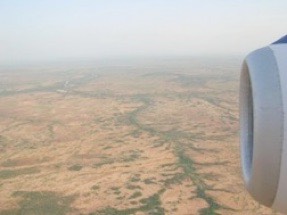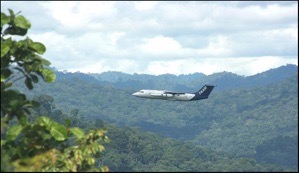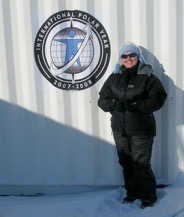My research in chemical oxidation focussed on the oxidation of chemical species emitted from trees and seaweed, as well as understanding the transport of pollution to the Arctic.
Oxidation in the Tropics
How are Volative Organic Compounds (VOCs) oxidized in the tropics?
Globally tropical forests are estimated to account for almost half of all biogenic VOC emissions into the atmosphere. The most effective oxidant in the atmosphere, and main pathway for the destruction of VOCs, is the hydroxyl (OH) radical. Produced from the photolysis products of ozone reacting with water vapor, OH rapidly reacts with carbon monoxide (CO) to form the hydroperoxy (HO2) radical, which itself quickly reacts with nitric oxide (NO) to reform OH. The measurement of OH and HO2, while highly challenging, provides a means to understand the oxidative capacity of the atmosphere.
We measured OH and HO2, with a low pressure Laser-induced fluorescence instrument, aboard the BAe-146 UK research aircraft in Borneo, Malaysia (OP3) to understand the impact of organic species such as isoprene on the tropical troposphere. In contrast to the high VOC area of Borneo, we also measured OH and HO2 in West Africa (AMMA) to understand the impact of the West African Monsoon on tropospheric composition.

Oxidation above the African Sahel
Sahel, Niger before the Monsoon
R. Commane, et al.: Observations of OH and HO2 radicals over West Africa, ACP, 2010
D. Stone, et al.: Impact of isoprene and NOx, ACP, 2010
M.D. Andres-Hernandez, et al.: Peroxy radical partitioning during the AMMA radical intercomparison exercise, ACP, 2010
C.H. Mari, et al.: Atmospheric composition of West Africa: highlights from the AMMA international program, Atmos. Sci. Let., 2010

Oxidation in a high VOC environment
Borneo, Photo by Martin Irwin
D. Stone, et al.: Isoprene oxidation mechanisms: measurement and modelling of OH and HO2 over a South-East Asian tropical rainforest during the OP3 field campaign, ACP, 2011
A. R. MacKenzie, et al.: The atmospheric chemistry of trace gases and particulate matter emitted by different land uses in Borneo, Phil. Trans. R. Soc. B., 2011
C.N. Hewitt, et al.: Overview: oxidant and particle photochemical processes above a south-east Asian tropical rainforest (the OP3 project): introduction, rationale, location characteristics and tools, ACP, 2010
_________________________________________________________________________
Oxidation in the Arctic
What controls oxidation in the polar boundary layer?

In the light-limited and dry polar atmosphere, OH and HO2 levels are expected to be minimal. However, as part of the COBRA project affliiated with the International Polar Year 2007, we measured OH and HO2 in the spring-time polar boundary layer of northern Quebec. Surprisingly high levels of OH and HO2 were generated from the photolysis of species such as ozone and formaldehyde (HCHO).
Kuujjuaraapik, Quebec, IPY 2007
P. M. Edwards, et al.: Hydrogen oxide photochemistry in the Northern Canadian spring time boundary layer, JGR, 2011
S.J. Moller, et al.: Measurements of nitrogen oxides from Hudson Bay: Implications for NOx release from snow and ice covered surfaces, Atmos Env, 2010
A.S. Mahajan, et al.: Evidence of reactive iodine chemistry in the Arctic boundary layer, JGR, 2010
_________________________________________________________________________
Oxidation in the Marine Boundary Layer
Can seaweed have an impact on the composition of the marine boundary layer?
Iodine monoxide (IO) is an iodine-based oxidant that is present in high concentrations in marine environments. IO can lead to ozone destruction and new particle formation but point measurements of IO have been limited. A low pressure laser-induced fluorescence instrument (adapted from the HOx LIF system) was developed to measure iodine monoxide (IO) at low concentrations.

For our study of coastal iodine impacts at Mace Head Atmospheric Research Station on the west coast of Ireland, we measured the highest concentrations of IO at daytime low tide and a strong dependance on tide height was observed. The largest source of iodine was laminaria digitata. Image courtesy of the Seaweed Site
Over the open ocean (RHaMBLe cruise) IO was less than 2 pptv. However, this is enough to affect ozone levels in the marine boundary layer [Read et al., Nature, 2008].
R. Commane, et al.: Iodine monoxide at a clean marine coastal site: observations of high frequency variations and inhomogeneous distributions, ACP, 2011
C.S.E. Bale, et al.: Novel measurements of atmospheric iodine species by resonance fluorescence, J. of Atmos. Chem., 2008
J.D. Lee, et al.: Reactive Halogens in the Marine Boundary Layer (RHaMBLe): the tropical North Atlantic experiments, ACP, 2010